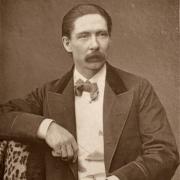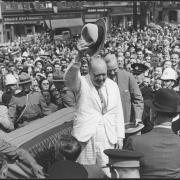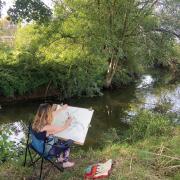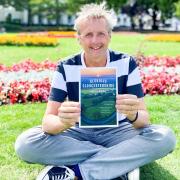Travelling on a bus from Cirencester to Gloucester, I am struck yet again by the way it is an opportunity to step into the past. I hasten to add that I’m not referring to the rattling and shaking from the road. It is the journey itself that makes me feel as if I’m following a trail into an ancient world.
At the edge of the escarpment, there are views of Crickley Hill hillfort, Gloucester in the Severn Valley below, and today, the Malvern Hills are just visible in the far distance to the north-west.
For someone like me, who doesn’t drive but is on the hunt for Gloucestershire’s prehistoric past, bus travel is a wonderful escape. I find myself stepping into the world of others who have come before. I begin to feel part of a greater community; a community that has always been there behind me and just needs a voice.

On this particular bus trip, it is worth knowing that where the route passes near Birdlip and the Barrow Wake area opposite Crickley Hill, this was the site of a small Iron Age settlement. Some burials were excavated near here, one of them containing extraordinary grave goods including a large polished metal mirror – possibly a scrying mirror – and a knife with an animal-headed handle.
Specialists haven’t been able to identify the gender of the person in that grave, but the objects can be seen in the Birdlip Treasure display at the Museum of Gloucester.
The mystery about who they were, and what they did, was what first inspired me to write a novel that aims to recreate the lives of an Iron Age community in the Cotswolds.
The locations I describe in the book are reconstructions of real archaeological sites, such as the earthworks and metalworking activity found near Bagendon, and so, naturally, part of my research led to many other bus rides.
The bus from Cirencester to Cheltenham travels along the A435 and the Churn river valley. The Perrott’s Brook stop, where the little stream that waters the Bagendon valley meets the larger Churn, is where I get off. The quiet village of Bagendon sits on the valley side, to the west of the main road.

Standing there, I can imagine the much busier and sometimes industrial atmosphere of the Iron Age estate down where water was plentiful and the sunny valley beyond was alive with animals and working people.
The people here were metalworkers, taking iron ore and processing it at the forefront of the new industry. They were even minting coins. The Corinium Museum cares for the objects that were found here during the excavations, and these include a coin mould for currency which would have been smaller than a five pence piece.
Taking these journeys, I’ve often found myself wondering what were their lives like? How did they speak to their gods and what did they think of the relics from previous ages that were still visible in the landscape, such as long barrows? What adventures did they get up to? And what were their fears for the future, as the Roman invasion established a new encampment nearby, later known as Corinium (which we know as Cirencester)?
Perhaps these questions come from my background as a primary school teacher. Or all my years of being involved as a volunteer archaeologist with a team from Bournemouth University. I’ve lately been involved in excavating a Neolithic long barrow, and I love it when visitors to our open days realise that in so many ways, apart from the passage of time and technology, the people of prehistory were like us.

Additional bus trips led to archaeological sites near Stroud and the scarp edge of the Cotswolds. Then even further afield where, after Westbury-on-Severn, it is possible to glimpse across the width of the Severn between Arlingham on the east bank and Newnham on the west, where there may have been an Iron Age river crossing. The upper deck of a bus is a wonderful vantage point.
My publisher is Crumps Barn Studio, and together we’ve included a guide to the bus routes and archaeological sites as an appendix to my tale of adventure. I’m sometimes asked why it matters to me that all the details are as accurate as possible, but the answer is simple.
The Iron Age people have left no written record, so it’s up to us to tell their story.
In a world of ancient gods, emerging technology and a Roman invasion just over the horizon, what an incredible story it is to tell.
Kirin of the Dobunni by Anne Buffoni is in bookshops and online retailers now. https://www.crumpsbarnstudio.co.uk



























